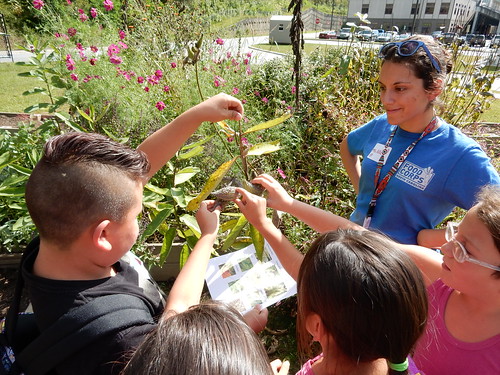
In celebration of Native American Heritage Month, guest blog writer Katie Rainwater, also a FoodCorps Service Member, shares her remarkable experience at Cherokee Central Schools, a 2014 USDA Farm to School Grantee.
Guest blog by Katie Rainwater, FoodCorps
Imagine this: A bright, sunny fall day in the Smoky Mountains of Western North Carolina. Fresh, organic greens, lovingly raised in Cherokee Central Schools’ garden, and harvested that same day. Now add 22 elementary students proudly waving signs and banners they decorated the day before, boasting the beauty of their garden bounty, and advertising their Fall Greens Sale. If you ever bought into the idea that “kids don’t like vegetables,” our elementary schoolers could have changed your mind that day. Stationed in front of the school during after-school pick-up time, every car and person within reach received a glowing description of the wondrous greens the students helped grow, the most popular being a local native variety called Creasy Greens. Bedecked in fruit and vegetable costumes, these kids were convincing adults that they should eat their veggies! As a genuine testament to their enthusiasm and love for their harvest, they sold almost all of the 321 pounds of greens harvested that day.
So how did we get here? At the beginning of the 2014 fall semester, Cherokee Central Schools (CCS) was home to a garden of 9 raised beds, managed primarily by the already established Cherokee Middle School Garden Club. Over the course of last year, with the aid of FoodCorps Service Members, and a USDA Farm to School Grant, CCS increased its garden from nine to 22 raised beds. Additionally, we were able to begin putting the campus greenhouse hydroponic system into more regular use, growing lettuce through some of the coldest months of the year. With the expansion came more opportunities to bring students to the garden, and the garden to the students. Produce grown on campus is used in classroom cooking, in taste tests in the cafeteria, and in the high school life skills class, where students develop and cook recipes not just for themselves, but for community events they help cater. Middle school students are also brought to the garden for soil science lessons, seasonal garden rotation days, and more exploratory days of tasting and learning. In addition, we bring special guests from the community to teach about the traditional Cherokee uses for the abundance of plants beyond our garden space--some edible, some medicinal, some good for crafts, but all valuable in the panacea of plant diversity in the Smoky Mountains.
Though neither FoodCorps Service Members are from this native community, we believe strongly in “place-based education,” meaning we strive to connect all of the learning in and around the garden to the historical and lived realities of our students. Our garden is built to reflect the landscape and traditions here in Cherokee. Our pollinator beds are overflowing with native flowers and herbs, such as sweet leaf, mountain mint, and milk weed. We also grow a bevy of corn beads, a variety of corn whose hard, tear shaped beads are used to make jewelry, and whose history speaks of hardships faced on the Trail of Tears. Our vegetables are grown primarily using heirloom varieties of seeds, saved for generations by Cherokee people and distributed every year to hundreds of community members in the Chief’s Garden Kit.
The garden now hosts afterschool garden club three days a week, and an ever-increasing array of students and teachers who enjoy the educational, and edible bounty of the garden during the school days. We count every leaf plucked and every seed planted in our garden as a small step towards the healthiest future for our students.
